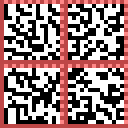ISO/IEC 29158 for Data Matrix and QR Codes
The ISO 29158 standard is a modification and an extension to the ISO 15415 standard designed to be more adapted to the grading of DPM (Direct Part Mark) codes.
|
●
|
It specifies a new acquisition methodology as well as new quality indicators specifically aimed at DPM symbols. |
|
●
|
Compared to ISO 15415, the new acquisition methodology simplifies the acquisition setup at the cost of calibrating of this setup and providing the resulting calibration parameters to the grading process. |
Calibrating an ISO 29158 setup
To perform the calibration, you must record the image of an "ideal" (perfect) code on the setup.
To have a successful calibration:
|
1.
|
Set up the Illumination and acquisition parameters (gain, exposure...) so that the Mean Light (ML, the mean value of the pixels of the center of the light cells) is in the range considered valid by the standard (70%~86% of the maximum gray level). |
To compute the Mean Light with Open eVision, grade the symbol with the default calibration parameters and retrieve it from the structure returned by GetIso29158CalibrationParameters.
|
2.
|
Record the ML as MLCal. |
Compute the other calibration parameters:
|
3.
|
RCal, the calibration reflectance, is the maximum reflectance of the calibration symbol, that is the gray level of the lightest cell. |
|
□
|
This gray level is computed as the mean gray level on the aperture. |
|
□
|
The aperture is a circle of a radius 50% or 80% of the cell width and centered on the middle of the cell. |
|
4.
|
SRCal, the calibration system response, represents the parameters used to set the brightness of the image at the calibration time. |
|
□
|
It can be the gain, the exposure, the global illumination due to the lighting angle or even a combination of those. |
|
□
|
Its nature does not matter as long as the same measure is used for SRCal and SRTarget. |
SRTarget is the same measure as SRCal but taken at the grading time. Since it is part of the calibration parameters, it should be computed at grading time and passed along the other parameters using SetIso29158CalibrationParameters just before calling Read.
ISO 291528 Quality Indicators
The cell contrast grade
|
●
|
The cell contrast grade is a measure of the relative difference between the mean reflectance of the brightest and of the darkest modules in the symbol. |
|
►
|
If the grade is low, the digitization is more difficult as it is difficult to separate the dark from the light cells. |
The cell modulation grade
|
●
|
The cell modulation grade is a measure of the variability and the reliability of cell colors. In essence, it is a combination of the modulation grade and reflectance margin grade of ISO 15415. It is thus a composite grade. |
|
►
|
If this grade is low, the digitization is more difficult, as the variations prevent finding an easy way to separate the white from the black. It is also less reliable, as the cells might be too close from the threshold for a clear dark/light classification. |
The fixed pattern damage grade
The fixed patterns of the symbols are what characterize the symbols as such.
|
●
|
The fixed pattern damage grade is a measure of the likelihood that the symbol is correctly located and identified in the image. |
|
►
|
If this grade is low, the detection and the grid determination are more difficult. |
|
□
|
Finder pattern damages can prevent the recognition of a candidate as a valid code. |
|
□
|
Timing pattern damages can prevent the correct computation of the grid. |



The areas relevant for this grade
The minimum reflectance grade
|
●
|
The minimum reflectance grade represents the difference between the calibration conditions and the acquisition conditions. |
|
►
|
It is set to 0.0 if the difference is too big for the grading results to be accurate and 4.0 otherwise. |


